Learning Outcomes
After this course learners will be able to:
- Describe the differences in the new Audeo M product family.
- Summarize the technological benefits of the SWORD chip and the benefits to patients wearing Audeo M.
- Describe the new features of AutoSense OS 3.0 and hearing performance in Audeo M.
Introduction
Thank you so much for joining me today to learn about the updates that accompany the launch of our new Marvel platform (Figure 1). Marvel draws together all of Phonak's cutting edge technologies into one single package. With Marvel, you can offer your patients the best hearing possible in any situation, with sound quality that is second to none. At Phonak, we are passionate about creating hearing solutions that engage people's lives. The new Marvel platform expresses our boundless commitment to improving hearing without limitations. Regardless of the listening environment, patients wearing these devices will experience unmatched hearing performance, speech understanding, and speech quality. With Marvel, there are no compromises when it comes to technology and innovation. Marvel has everything that you and your patients will need.

Figure 1. Phonak MarvelTM.
When developing Marvel, we took market feedback into consideration, from both patients and hearing care professionals. It became clear that across the board, ease of use is an important factor. As such, we placed a high level of importance on designing a portfolio of hearing aids that are not only innovative but also easy to use.
With Phonak Marvel, you will see:
- Improvements for rechargeable handling
- Better usability of the hearing aid push button
- Better handling of the hearing aid housing and battery doors
- Optimized performance in wind and noise
- Better patient experience of the TV Connector and Remote app
These are just some of the things that were taken into consideration to make sure that your patients feel confident in handling their hearing aids after leaving your office.
Before launching the new housing for Audeo M, we tested more than 50 different housings in a variety of environments to determine what was going to be the best for our patients. At Phonak in Switzerland, we even went so far as to build a wind tunnel to investigate the effect of wind turbulence and the benefits of the new microphone inlets in the housing.
The new housing includes many new features, such as:
- Rounded shape for comfort
- A multifunction button
- A redesigned multicolor indicator light (for our rechargeable models)
- New microphone port inlets (to reduce wind noise and hair noise)
- Improved battery door (for better handling)
Patients are constantly looking for something that is comfortable and easy to use. With Marvel, we have delivered what patients want for a great hearing experience.
Audeo Marvel Products
Let's take a look at the line up of products (Figure 2).

Figure 2. Audeo Marvel products.
The Audeo M-312 and the Audeo M-R models are in the greatest demand, so that's where we're going to begin. Binaural voice stream technology (BVST) is present in all models, as is direct connectivity, hands-free phone calls, and Roger (which we will talk about coming up). Not only that, we offer two great rechargeable options. We have three models that will include T-coil. We have amazing features at every level of technology. With the launch of Marvel, we're going to see rechargeability and connectivity down to the 30 level.
Rechargeability
Rechargeability is the top reason that would motivate a first-time user when selecting a hearing aid. This is something that we looked at when we first launched Audeo B Direct, and we still feel that this is a great motivating feature. Marvel features the leading industry solution: lithium-ion technology. We've seen such success with our previous versions that we're keeping what's great, and improving other things to make it even better.
We've listened to feedback from both you and your patients to improve usability. Now you have the option of having the hearing aids turn on automatically once they're taken out of the charger. It will take them about 1.5 seconds to wake up and then the standard six-second bootup time. With our super quick charging capability, patients don't need to worry about battery changing.
Another change we have made is the placement of the indicator light on the multi-function button to provide better visibility, while also maintaining discreteness. If your patient does decide that they want to turn the hearing aid on out of the charger, they can press that button and still see the indicator light so that they're aware of the hearing aid turning on. We've also changed the colors of the light, so it's a little bit more intuitive for your patients to understand what the colors signify (green means "on", red means "off", and an orange light means it's in the middle of the charging cycle).
Our batteries are reliable, engineered to last for six years. In addition, the battery is completely integrated into the hearing aid. A study conducted in New Zealand intended to compare the time savings and ease of use between Audeo B-R and the Audeo B-312 (Crowhen, 2018). Participants found it significantly easier to insert and take out the rechargeable hearing aid from the charger case. In fact, they performed this task about 75% faster than inserting a disposable battery into the Audeo B-312.
Our patients truly do feel that rechargeability makes their life easier. Now we've made it even easier because they're not going to have to turn their devices on. For patients who prefer to manually turn the hearing aid on and off when they take it out of the charger, there is an option in Target for you to make that change. We also have an option in our Remote App where they can make the change themselves.
The SWORDTM chip. Our new power management system has made all of these rechargeability changes possible (Figure 3). In previous rechargeable models, there was a separate power management system that was housed with the battery. The power management chip in Audeo Marvel rechargeable hearing aids is redesigned with new hardware and is now directly controlled and connected by the SWORD 3.0 chip. It is packed and sealed inside a new casing (for better reliability).
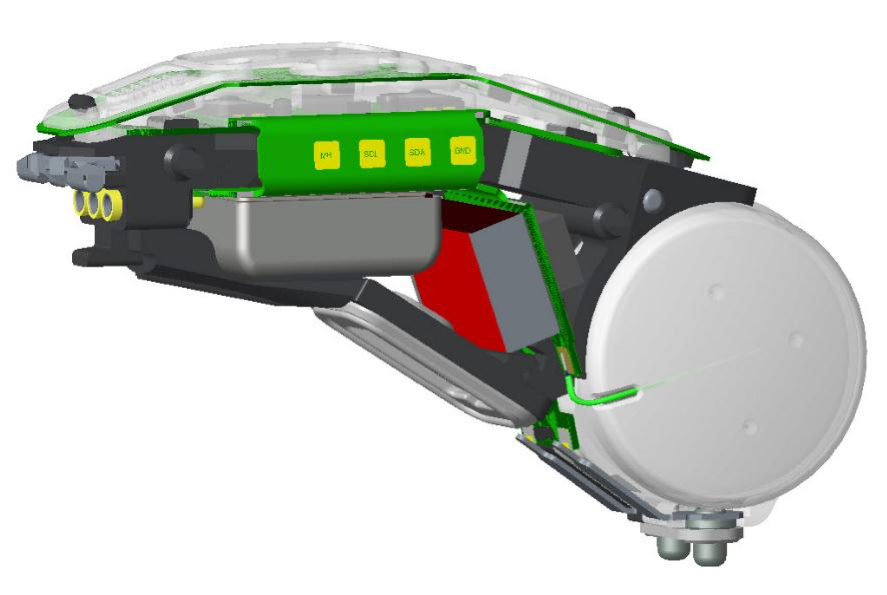
Figure 3. Audeo Marvel new power management system.
Now, both the patient and hearing care professional are more in control of the rechargeable hearing aid features, such as:
- Setting the automatic on/off in Target or Remote App
- Defining the time limit for when the hearing aids should switch on
- New multicolor indicator lights for better battery status information when the hearing aids are charging
- Making additional changes within the Remote App, such as the turning on and off function as well as battery state of charge
Charging Options. Figure 4 shows all of our charging options.

Figure 4. Charging options.
The new Mini Charger Case was specifically designed for the new Audeo M-R models. In response to your feedback, the case was designed with a lid in order that it could be closed, protecting the hearing aids.
The case in the middle of Figure 4 is the Charger Case Combi. It looks the same as our previous version, but the charging inserts have been changed out and optimally adjusted to fit the two new rechargeable models that are now a bit smaller and sleeker. The case is backward compatible and is able to be used with our previous rechargeable hearing aids. In the somewhat near future, this Combi Case is going to replace the previous RIC and BTE cases.
On the right of Figure 4, you will see that the Phonak Power Pack is still available. This feature provides the ability to charge on the go and some security and comfort in knowing that you've got charging no matter what happens when it comes to power or electricity.
One thing that I'd like to note is there is a special technique when it comes to removing these hearing aids from the case. We call this technique "the lean back". Essentially, you're going to have your patients pull the hearing aid toward them a little bit as they lean it back and then pull them straight out of the case. This is going to be consistent in both the Mini Charger and the Combi Case.
Multi-Function Button
Our previous discussion about the indicator light leads to the multi-function button (Figure 5). By having side-facing microphone inlets, we were able to create a larger button, which improves usability and makes it easier for patients to handle. You can feel comfortable that although you're fitting your patients with a small hearing aid, it comes with a multi-functional button that is easy to use, especially for hands-free phone calls. The new multi-function button has been redesigned and is integrated in the housing plateau. Most importantly, you can change the settings and change the defaults in Target so that you're giving your patients the flexibility and the usability they seek.
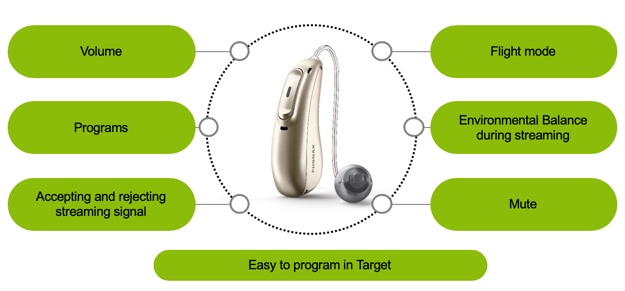
Figure 5. Mult-function button.
As you can see, there are many different things that can be done with this button, depending upon what your patient is looking to have control over. You can make these button program changes in Target. One thing that I do like to point out is that the button defaults are:
- Short press = volume up and down
- Long press = program change
This is important for functionality, for having on-ear phone call control. I do urge you to not make changes to those settings, but of course, you can have other settings as well with the button.
New Microphone Inlets
As I mentioned, we have new microphone inlets for reduced wind noise (Figure 6). In the circled area of Figure 6, you can see the two side facing inlets, and there is another one at the bottom of the button. By facing them to the side, the microphones are protected from turbulence. Through our extensive testing, we found that wind and hair noise is reduced by up to five dB (when compared to the previous Belong hearing aids). Another thing to note is that even though there are three microphone openings, we still do have the two microphones inside the hearing aid.
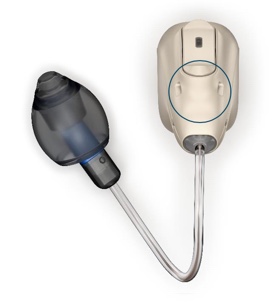
Figure 6. Microphone inlets.
Design Improvements
We made improvements to the battery door based on market feedback. We improved the handling of the battery compartment so that it is not only easier to open, but the insertion of the battery into the compartment is also more intuitive. In addition, the battery doesn't fall out quite as easily.
Another upgrade is the improved left and right color indicator (Figure 7). Now, it will be easy to see on both the hearing aid and our redesigned receivers. In addition, we have streamlined the color indicators down to just two. All of the Marvel Zinc Air hearing aids will have one type, and all of the Marvel rechargeable hearing aids will have another type. They're all going to be easy to insert, but there won't be a whole array of different color indicators that you'll have to figure out.
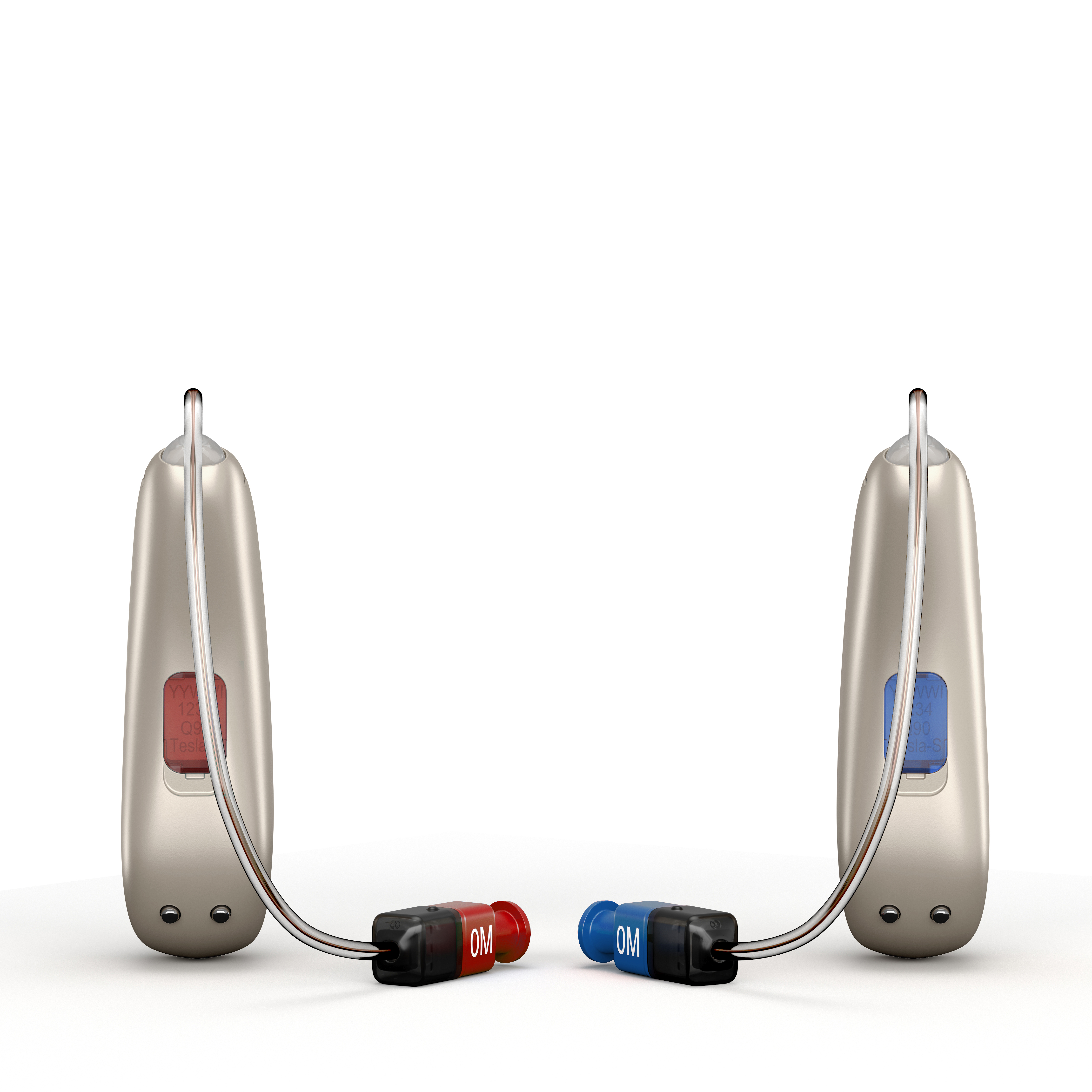
Figure 7. Improved left/right color indicators.
Our devices are still available in a wide variety of color options, which are mainly the same as Audeo B, except for the Beige is now in a lacquered color (Figure 8). Our color choices are Beige (now in a lacquered color), Sandalwood, Champagne, Sand Beige, Silver Gray, Graphite Gray, Velvet Black, White, and Chestnut.

Figure 8. Color options.
Sound Delivery System (SDS) 4.0
With the launch of Audeo Marvel, we are introducing the next generation of acoustic coupling with our new Sound Delivery System (SDS) 4.0. It includes a variety of receiver improvements, new domes, and custom shell options. These changes are going to increase comfort and also provide great clear sound quality.
SDS 4.0 offers the following highlights:
- Choice of receivers with our newly designed Receiver 4.0 portfolio, including the new M receiver
- New tactile click system between receiver and dome
- Re-designed retention holders
- New proprietary wax system (CeruShield Disk)
- A range of newly designed domes, featuring a new Cap dome
- New SlimTipTitanium and RIC SecureFit
M Receiver
Our new hero of the receiver family is the M receiver. Hearing care professionals like the acoustic performance of a P receiver, but we heard from many professionals who expressed a need for the receiver to be made small enough to fit the majority of their patients. We took on the challenge and designed this new addition to our receiver portfolio.
The gain of the M receiver is between that of the S and P, with more gain in the lower frequencies and a higher peak gain (3-4 dB higher). The gain of the M receiver is closer to that of the Power receiver, but the housing size is smaller, more resembling the size of the S. Now you can provide great sound quality and acoustic performance, with an increased fit rate for more of your patients.
Next, let's review the fitting ranges (Figure 9). The M receiver looks similar to the Power fitting range, but in terms of size, it's going to look a lot more like the S. Another thing to note is that the M receiver is now the default receiver. When you order a set of Marvel hearing aids, the default will be the M. Realistically, you would go down to the S receiver if you're dealing with someone who has a very small ear canal.
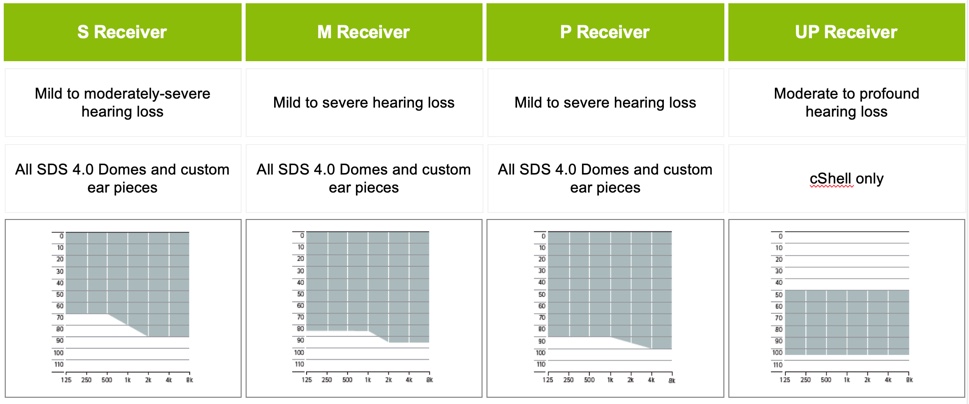
Figure 9. Fitting ranges.
SDS 4.0 Receiver Highlights
Now let's take a look at what's has changed (Figure 10). You may have noticed from the previous slide that the M receivers look a little bit different than what you've seen in the past. The first thing that has changed is that third pin, which acts as a ground to manage electrostatic discharge. What this also means is that these are not backward compatible with our previous hearing aids.
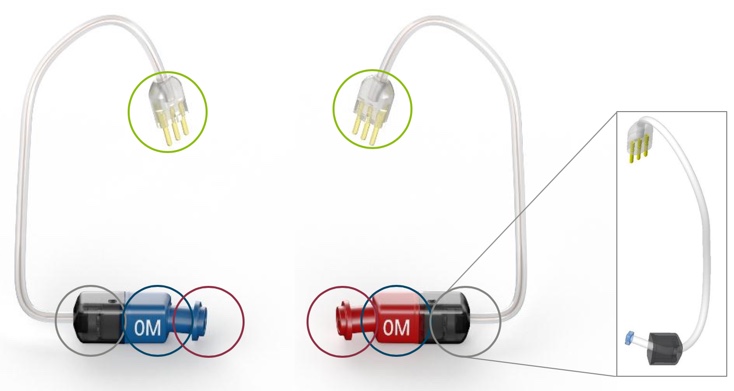
Figure 10. SDS 4.0 receiver highlights.
In addition to changing the appearance, we have also improved the robustness and the reliability of our receivers. Previously, the cable was simply glued to the housing of the receiver. Over time, it had a tendency to become weak and prone to breaking. On the right-hand side of Figure 10, you can see that the wire itself now goes through and is anchored inside the receiver so they are much more reliable and sturdy.
Another thing that we updated in response to market research is that we have made these receivers easier to identify. With previous receivers, it was difficult to see whether there were red or blue markings on them. Now, it's very easy to see in which ears these belong, and easier to see their size and length.
Something you will also notice when you receive your starter kit is that the naming of the receivers has been simplified. This particular receiver would be called M Receiver 4.0 0L.
The last design difference you can see is the receiver spout. This design offers two areas of benefit. First, it will work in conjunction with our new wax protection system. Essentially, with the larger, redesigned spout, we now have a larger wax protection system such that more wax can accumulate before it needs to be changed. The other benefit is with that spout, you have a tactile connection so that you know when the dome is clicked on to the receiver.
SDS 4.0 Dome Portfolio
Our entire portfolio of domes has received a makeover (Figure 11). Our portfolio includes four dome designs:
- The Cap Dome. Our newest member of the dome family is designed to suit patients with particularly narrow ear canals. As the name suggests, the cap covers the end of the receiver spout.
- The Open Dome. One of our most popular domes, the open dome has been redesigned into a disk shape for more comfort and better retention.
- The Vented Dome. Note that it's no longer called the "closed" dome. This balloon shape provides more comfort. It does still have venting, which provides a middle option between our open and our power domes.
- The Power Dome. We have optimized the size of the power dome for comfort. Our previous power domes were perhaps a little bit on the large side. The lateral seals have been made smaller, providing the wearer with a more comfortable dome that sits well in the ear without moving.
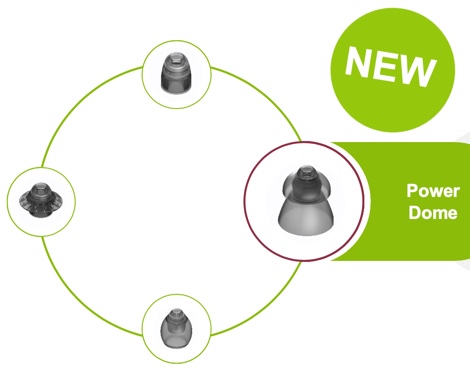
Figure 11. SDS 4.0 dome portfolio.
CeruShield Disk
We are excited to introduce our new CeruShield Disk wax protection system (Figure 12). With the bigger spout design, we had the opportunity to rethink the wax protection system so that we could offer even more benefits and ease of use for your patients. The dispensing wheel contains eight fresh CeruShield filters that are easily accessed by rotating the protective cover (using the thumbs and twisting in the direction of the arrows). A new filter can be revealed whilst the cover protects the unused filters. There is also a disposal area for the used filters, indicated by a trash can icon. Additionally, because it's a larger wax receptacle, they don't have to change the filters quite as often.

Figure 12. CeruShield Disk wax protection system.
Retention Wire
As I mentioned, there is a new retention wire (Figure 12). In the past, I would always need to make two attempts to put the retention wire on the receive, because inevitably, I would put it on the wrong way the first time. This new snap-on design makes it easier to orient and put on. We've also made the filament itself a bit shorter and ergonomically shaped so that it's more comfortable for patients. Personally, I know a lot of offices were snipping them to make them shorter, which resulted in a scratchy edge. This provides a little bit more comfort for your patients.
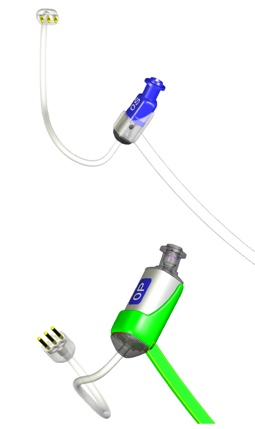
Figure 12. New retention wire.
Custom Ear Pieces
With this initial launch of SDS 4.0, we are offering the ability to order the custom tips that you know and love (acrylic slim tips and the C-shells). However, in February of 2019, there will be two new options available. The first option is the RIC SecureFit. It is made of a soft, comfortable silicone material. They can be made very small, and they are fit with retention for a secure fit. The second option is the new SlimTip Titanium. This is will allow us to fit those really tiny ears. Since it is titanium tough, it is a robust design. As such, the patient does not have to worry about breakage or cracks.
Lastly, we do have a new connector for the slim tips: SlimTip Link. This can be used with SlimTip Acrylic and Titanium earpieces and offers a secure and reliable connection to the SDS 4.0 receivers. SlimTip Link replaces the existing Flexfit connector.
Audeo M Connectivity and Streaming
The Sonova Wireless One Radio Digital (SWORDTM) chip was originally released with Audeo B direct. With the launch of Audeo M, we've made updates to SWORD in order to enable multiple connectivity protocols. We have devised a smaller chip that is not only faster but also achieves more. In fact, it's doing more than our competitors in both the hearing aid realm, as well as the commercial headphone realm. The SWORD chip will allow your patients to stream everything that they want to stream.
The power management of SWORD during streaming is a key advantage. This is going to allow for rechargeability and for connectivity. Everything is going to be controlled by this chip. We're also going to have increased robustness against any sort of interference when it comes to Bluetooth. It is worth noting that these hearing aids are able to connect to a myriad of devices, as long as they have Bluetooth. This includes iPhones, Android phones, Mac computers, Microsoft and Apple tablets, among others. We go far beyond the ability to connect to just phones.
Bluetooth Protocols and Applications
With Marvel, we wanted to create our own chip and use our own proprietary Bluetooth protocols and extensions of protocols. Let's take a look at those protocols and everything that the Marvel is able to do.
- Bluetooth Classic is the standard for transmitting audio (voice or music). This allows for hands-free phone calls streamed to both ears (HandsFree Profile, or HFP), and also binaural and stereo music streaming (Advanced Audio Distribution Profile, or A2DP).
- Bluetooth LE is the standard for transmitting data. It is used for both the Phonak Remote App and for wireless fittings with Noahlink Wireless.
- Binaural VoiceStream Technology is used for best hearing performance in difficult situations with full audio streaming between two ears.
- Roger Technology will be available in the near future, which allows for the best hearing over distance and noise as well as groups.
- AirStream is a proprietary, low energy protocol that allows for "plug and play" solutions for high-quality TV streaming.
Binaural Phone Calls and Audio Streaming
With Audeo M, we offer direct connectivity with binaural phone calls. How do we achieve this? We've made a proprietary extension to the Bluetooth Classic HFP in order to deliver a binaural signal. The patient is going to hear the ring tone and the phone call in both ears.
Similarly, with audio streaming, we have created a proprietary extension for the Bluetooth Classic A2DP signal, in order to provide binaural listening. During audio streaming, Environmental Balance defaults to microphone attenuation so that patients can have a comfortable streaming volume, that they can adjust it as needed (on their hearing aids or in their app) to prioritize what they want to focus on.
Our Environmental Balance system creates the best possible ratio between the ambient noise and the streamed signal, whether patients are on a phone call, watching TV using the T-coil or TV connector, or enjoying any other media streaming. With Environmental Balance. when you're streaming a signal, it essentially ties together the streamed signal with the environment or the microphone signal. As you make the streamed signal louder, it's going to make the microphone or environmental signal softer, to improve the signal to noise ratio. We made changes to the low frequencies of the microphone signal to ensure that the person on the other side of the phone call is also able to pick up the person's voice.
TV Connector
With Phonak Marvel, we wanted to focus on making television even easier to listen to. As such, we improved our TV Connector (Figure 13). With the addition of manual controls on the TV Connector (on/off buttons and volume control), patients can make changes on the TV Connector without impacting the volume for anyone else. We designed the TV Connector with patients in mind. It is easy to work with. Straight out of the box, you plug it in, and it automatically goes into pairing mode. There is no complicated process for pairing. It happens almost immediately.
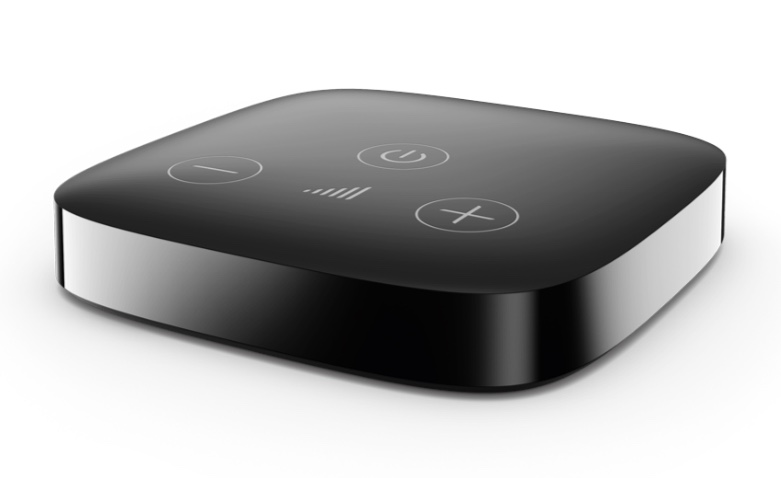
Figure 13. New TV Connector.
With our newly designed TV Connector, we've added an additional mode for improved usability. Previously, the two options were to automatically connect to the hearing aids when the streamed signal was detected or to manually connect the hearing aids by pressing a button. We've now added a third option for a silent mode so that if the user is in the manual connection mode and they go into the range of the TV Connector, they won't hear that audible chime letting them know that it is an available stream.
Another update is that the optical cable is now the default cable, and it comes attached to the TV Connector. This gives us some benefits when it comes to sending a digital signal. It fixes the audio output levels so that it's independent of the TV volume and it's not going to mute the speakers of the TV. Additionally, this new TV connector is now Dolby compatible.
RogerDirect
The new Marvel platform brings another breakthrough feature called RogerDirect (Figure 14). Roger is proven technology that improves the signal to noise ratio in very difficult situations. In the past, it was required to have a Roger microphone and Roger receivers. Now, Roger will be able to stream directly to Roger hearing aids, so that Roger will be more accessible to more patients and they will not have to have external receivers. This is a major innovation that makes Roger technology easier to use, more attractive for a broader group of our patients, regardless of what type of hearing loss they have. This is a feature that's going to be available later in 2019, likely sometime in early fall. Patients will not need new hearing aids once this feature is available. At that time, all that will be required is a firmware update.
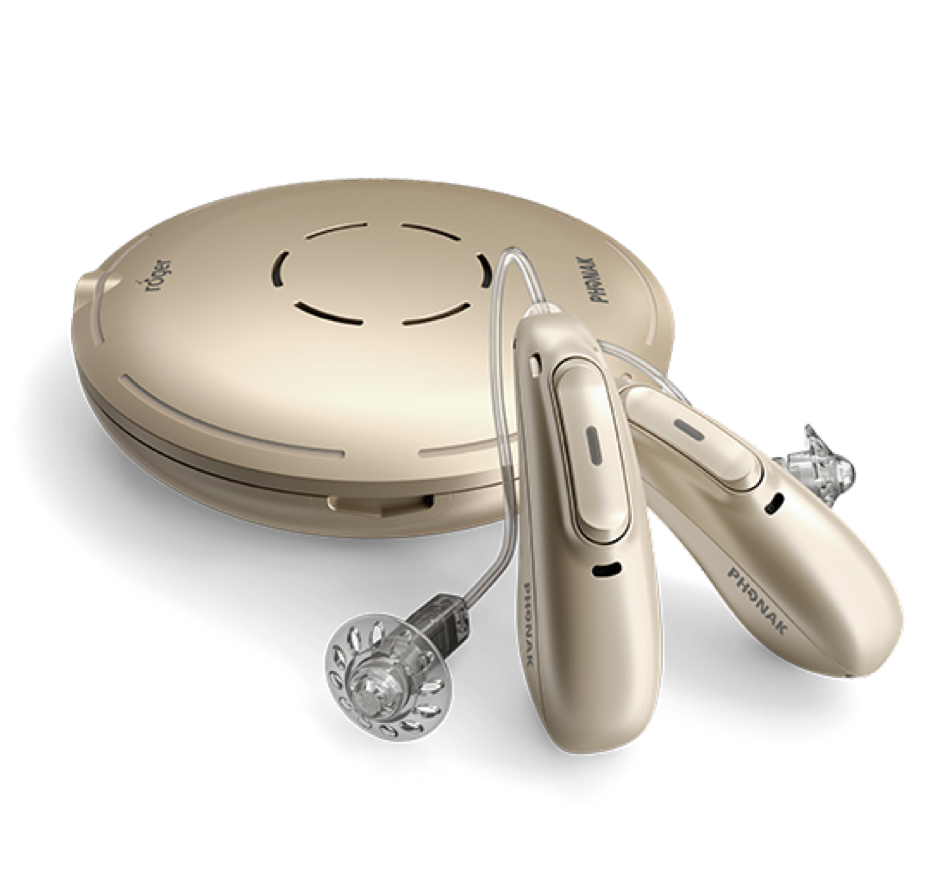
Figure 14. RogerDirect.
AutoSense OSTM 3.0
Phonak Audeo M is the world's only hearing aid that directly streams all audio content from any type of device (iOS and Android) to both ears. We still are the only manufacturer that offers hands-free calling with Own Voice Pickup. While all of these high-tech features are impressive, hearing performance is still the main motivating factor that brings patients into your office. Ultimately, people want a hearing aid that's going to help them hear better.
Figure 15 shows a schematic of AutoSense OS. We've improved the classifier so that AutoSense OS 3.0 will provide more stable speech recognition in difficult environments, as well as more precise music recognition. AutoSense OS adapts seamlessly and applies a calculated gain to different hearing situations and environments. Depending on the listening environment, the sound cleaning features and directional modes will blend in and out. The core of AutoSense OS is based on a classifier structure of non-exclusive blended programs (Calm, Speech in Noise, Comfort in Echo, Comfort in Noise) and exclusive programs (Speech in Loud Noise, Music and Speech in Car).
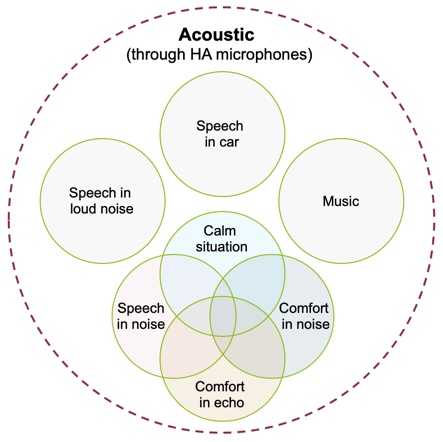
Figure 15. AutoSense OS 3.0.
An additional innovation with AutoSense OS 3.0 is situation-dependent compression. Evidence has shown that more severe hearing losses have better speech intelligibility and acceptance for slower compression in noisy environments than with fast compression. A new study conducted in Oldenburg, Germany showed significantly reduced listening effort for hearing aid wearers with milder hearing loss, using slower compression for speech in noise (Winneke, Latzel, & Appleton-Huber, 2018). This means that applying slow compression in noisy environments is no longer hearing loss dependent, and no longer exclusive to the music program. This is something that's going to happen depending upon the environment that your patients are in. Slow compression will preserve the differences in sound levels between the ears, which helps to maintain localization cues. Furthermore, it will improve speech intelligibility by preserving intensity and modulation differences, and it's also going to preserve the temporal envelope. There are many benefits when it comes to this new compression strategy.
Top-Rated Streamed Sound Quality. TV watching is important in our society. In fact, hearing aid wearers rate TV watching as one of the top four listening situations where they want to hear better (MarkeTrak 9, 2015). In Sweden, they watch an average of 2.0 hours of TV per day, as compared to the US, which is about five hours a day (www.statista.com). The effect of sound dissipating when listening to signals in the far-field, such as a TV in an average sized living room, is going to pose a challenge for listeners with hearing loss. In order to address this customer need, we wanted to take AutoSense OS a step further.
We already discussed the TV connector, but there's even more that we can do when it comes to the streamed signal. As shown in Figure 16, we now have classified the streamed signal so that it's going to automatically make changes whether the streamed signal is speech heavy or music heavy. With Marvel, the hearing aid detects if a movie or show is playing more speech or more music, and it's going to seamlessly adapt the gain approach to offer the best amplification for that signal. The detection and the classification occur automatically and there's no interaction needed from your patient.
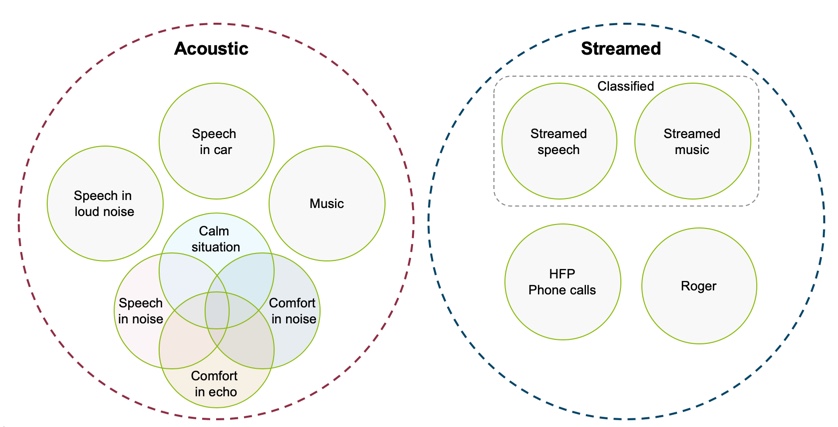
Figure 16. Acoustic signal vs. streamed signal.
In order to test this automatic detection and classification, we wanted to conduct a study. We enlisted the help of SenseLab in Denmark (an independent party that conducts hearing testing). Fifteen trained hearing impaired participants with mild to moderate hearing loss were recruited for this study. There were nine male and six female subjects, ranging in age from 67 to 84 years old. The participants tested seven different hearing aids and respective TV streaming solutions: the new Phonak Audeo M hearing aids, as well as the previous Audeo B-Direct hearing aids, and premium hearing aids from five other competitors. Six different audio-visual TV broadcast samples were selected to test the streaming solutions, including speech only, music only, and various speech in noise samples. They compared the Phonak streaming signal against the older Phonak product and the other five competitors. Participants rated Phonak M as the most preferred streaming solution overall, with the highest stream quality (Legarth, Latzel & Rodrigues, 2018).
Reduced Listening Effort in Noise. We also conducted a study to determine reduced listening effort in noise. Binaural Voice Stream Technology (BVST) is a feature that is going to provide the best hearing for patients regardless of the environment that they're in. BVST is our StereoZoom feature, which is available in our Speech in Loud Noise program. The motivation of this study was to use an objective measure (e.g., EEG brain activity) to show differences in listening effort when using different hearing aid algorithms under the same environmental conditions.
The study used 20 participants, all of which were hearing aid wearers with mild to moderate hearing loss. The average age of the participants was 70.9 years. Twelve of the participants were female, and eight were male. Brain activity was recorded using a 24 channel wireless EEG system with 24 electrodes mounted into a custom-made elastic EEG cap and arranged according to the International 10–20 system (Jasper, 1958). While participants were wearing this cap, they did sentence recall studies (OLSA sentence testing).
Figure 17 shows the objective results of this study. First, we benchmarked so that we can look at Real Ear Sound (RES), which is our calm situation, versus StereoZoom (SZ), which is speech in loud noise. When we see Real Ear Sound in an easier environment and in a harder environment, there are a lot more yellow and red areas, meaning there is more brain activity or more listening effort. When we look at the performance with StereoZoom, we see a lot more blues within that alpha band, indicative of less listening effort. It is clear that StereoZoom active patients have an easier time with sentence recall (Winneke, Latzel & Appleton-Huber, 2018).
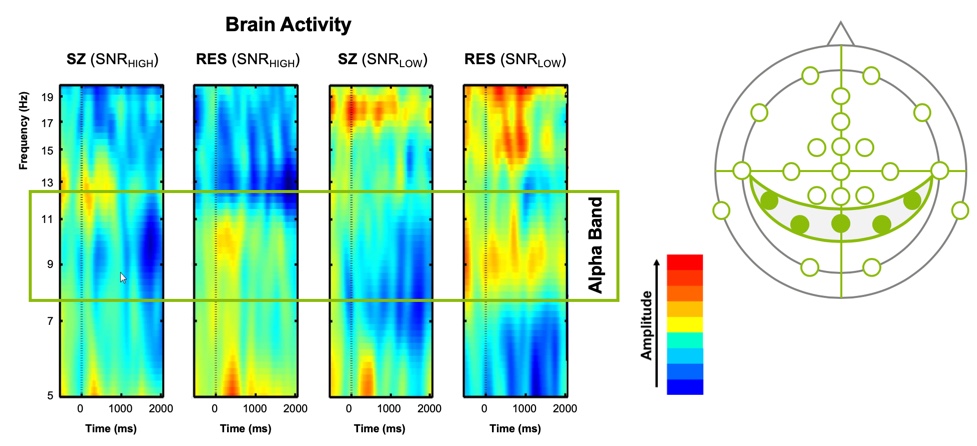
Figure 17. EEG results.
We took this study a step further and had these patients rate their listening effort subjectively (Figure 18). When we tested our product in Speech in Loud Noise (SPILN) and put it against one of our competitors (COMP), participants indicated that using Phonak, they had to put forth less listening effort, regardless of the environment that they were in. In easy or more difficult listening situations, they still felt they were hearing better with a Phonak.
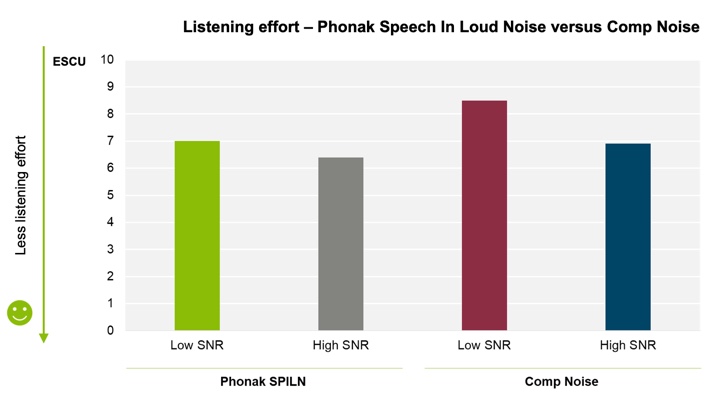
Figure 18. Subjective ratings.
In summary, by offering your patients a product with StereoZoom and Speech in Loud Noise, you are freeing up cognitive resources that can be used for something other than listening effort. It truly is easier to listen with Phonak hearing aids.
Summary and Conclusion
Let's take a peek at the entire product line (Figure 19). First, we are going to be releasing the Audeo M-312 and the M-R. Then, in February 2019, we will see the addition of the Audeo M-312T and M-13T. In early fall of 2019, the rechargeable telecoil option will be available (Audeo M-RT).

Figure 19. Audeo Marvel Product Line.
To conclude, the Marvel platform is going to provide your patients clear rich sound from first fit and every day thereafter. The results are incredible in every listening environment that you can imagine.
Thank you for joining me today. I encourage you to continue to seek out more information about this product because there is so much to learn. We will be having many different regional trainings and other trainings around the country. Reach out to your Phonak representative or your Phonak trainer and see how you can get involved. Welcome to the future with Phonak.
References
Winneke, A., Latzel, M., & Appleton-Huber, J. (2018). Less listening-and memory effort in noisy situations with StereoZoom. Phonak Field Study News.
Citation
Hoffman, A. (2019). Marvelous products and solutions: Phonak audeo marvel. AudiologyOnline, Article 24481. Retrieved from https://www.audiologyonline.com


